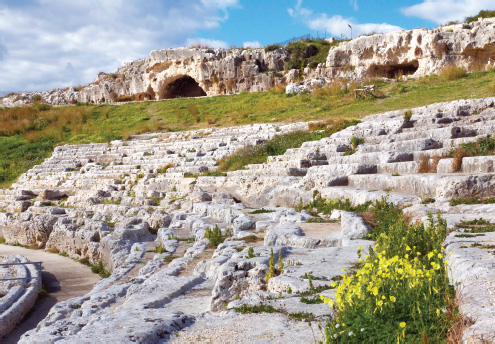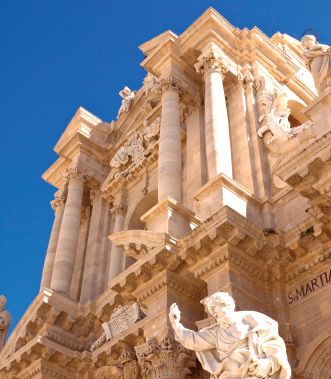![]()
SYRACUSE was one of the great cities of the Greek world. The wealth she owed to the excellence of her harbour inspired two of the great sieges of antiquity. In 416–413 BC the Syracusans defeated the vast Athenian war machine. A generation later the city was controlled by a tyrant, Dionysius I, the calibre of whose coinage has never been excelled. Rome was to be a more powerful enemy than Athens, and despite the ingenuity of Archimedes Syracuse fell after a protracted siege of 214–212 BC. There followed a long period of prosperity, broken only by the disintegration of the western empire in the fifth century. Belisarius won the city for Byzantium in 535, and it was controlled by the eastern empire until the Arab conquest of 879. With the Norman occupation of 1086, Syracuse was for the first time subordinated to Palermo, upon whose subsequent fortunes she was to depend.
The Corinthians settled on the former island of Ortigia in the eighth century BC, but Dionysius’s city was altogether different in scale, defended by walls with a circuit of twenty-two kilometres. The expansion of modern Siracusa has affected the context of her most famous classical monuments, in the former suburb of Neapolis. Near the east entrance to the Parco Monumentale is what remains of the Roman amphitheatre. Three hundred metres or so north-west is the much more appealing Greek theatre, marvellously placed with wide views over the coast. Behind are the celebrated quarries, great gashes in the hillside where, as Thucydides relates, Athenian prisoners were put to work. The largest is the Latomia del Paradiso, forty-five metres deep in places, with the Ear of Dionysius – the cavernous excavation so named by Caravaggio in 1608. It is regrettable that public access is resticted to a small area, and that the atmospheric Latomia di Santa Venera to the east is now inaccessible.

The Greek theatre.
At the northern extremity of Dionysius’s city, some eight kilometres by road from Ortigia, is his Castello Eurialo. Built in 408–397 bc, this was one of the most sophisticated fortifications of the time, with an elaborate system of tunnels and sallyports. The fort withstood two years of the Roman siege. It is particularly atmospheric in the late afternoon. Other tourists depart, leaving you to the sound of the wind; a curious herdsman may pepper you with questions – ‘How old are you?’ ‘Are you alone?’ ‘Are you married? ‘Why not?’ – as he pauses to gather his flock.
The archaeological museum east of the Parco Monumentale is uncompromisingly modern. It must be one of the most perfectly arranged institutions of the kind – a subtle orchestration of objects of every type with excellent photographs of the sites from which they came. Outstanding groups of Attic black figure vases and a handful of exceptional Greek sculptures are shown to real advantage. Further east, above a complex of catacombs of the Roman era, is the much rebuilt church of Santa Lucia, the virgin who was martyred there in AD 303.
Modern Siracusa has little to commend it. But persevere, for Ortigia – a scant kilometre long – is remarkable. The main road crosses to the Piazza Pancali, behind which are the substantial ruins of the Greek Temple of Apollo. Take the Corso Matteotti, forking right on the narrower Via Cavour, which opens into the north end of the Piazza del Duomo, at the highest point of the island. This is fringed with excellent buildings: façades of private palaces (the most spirited is the Palazzo Beneventano del Bosco); the sober archiepiscopal palace, begun in a late Renaissance classical mode by the Spanish architect Andrea Vermexio in 1618; and, not least, the cathedral, the Christian successor of the Greek Temple of Athena, much of whose structure still survives. Shattered by the earthquake of 1693 which devastated so much of south-east Sicily, the cathedral was rebuilt from 1725 to the design of Andrea Palma from Trapani. At the south end of the piazza is the tall façade of Santa Lucia alla Badia, to which the Burial of Saint Lucy, the charged masterpiece supplied by Caravaggio in 1608 for the high altar of the eponymous church, has now been transferred. The setting is, most appropriately, an ancient quarry cast in shade: two muscular gravediggers flank the prostrate corpse; one of the mourners is dressed in red, but otherwise the palette ranges from flesh to umber. The church of Santa Lucia is orientated so the light falls from the right.
To the south of the piazza, in the former Palazzo Bellomo, is the Galleria Regionale. The building, begun in the thirteenth century, has been ruthlessly restored. Among the pictures, pride of place goes to a masterpiece of Antonello da Messina, the Palazzolo Acrèidi Annunciation of 1474. Although a good deal of the surface is lost, this remarkable work shows how much Antonello had learnt from his experience of contemporary Netherlandish and southern French painting. Antonello absorbs, whether in the humanity of his types or the clarity of his detail. But he does not imitate. This in part explains why his impact on the Venice of Bellini was so immediate.

Cathedral: façade by Andrea Palma, 1725–53.
At the extremity of Ortigia is the Castello Maniace – named now after the Byzantine captain who took the body of Saint Lucy to Constantinople – built between 1232 and 1260 by the Emperor Frederick II, ruler in his mother’s right of Sicily. The recent restoration means that the visitor can now see one of the most rigorously planned of all medieval fortresses, before walking back through the narrow streets and passages of Ortigia, past silent relics of the many phases of Siracusa’s long urban evolution.